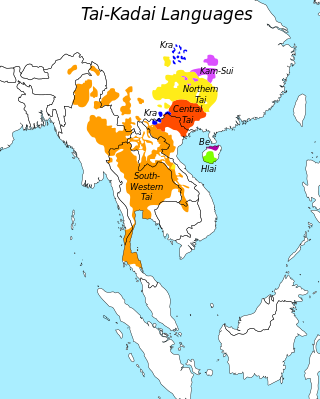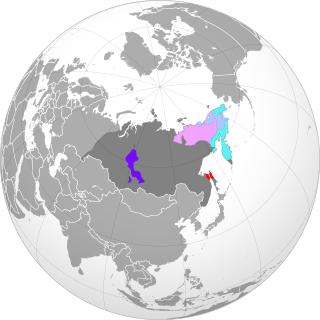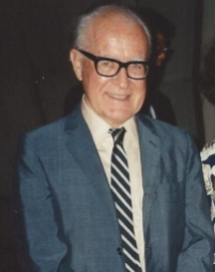Related Research Articles

Altaic is a controversial proposed language family that would include the Turkic, Mongolic and Tungusic language families and possibly also the Japonic and Koreanic languages. The hypothetical language family has long been rejected by most comparative linguists, although it continues to be supported by a small but stable scholarly minority. Speakers of the constituent languages are currently scattered over most of Asia north of 35° N and in some eastern parts of Europe, extending in longitude from the Balkan Peninsula to Japan. Like the Uralic language family, which is named after the Ural Mountains, the group is named after the Altai mountain range in the center of Asia.

Korean is the native language for about 81 million people, mostly of Korean descent. It is the national language of both North Korea and South Korea.

A language family is a group of languages related through descent from a common ancestor, called the proto-language of that family. The term family is a metaphor borrowed from biology, with the tree model used in historical linguistics analogous to a family tree, or to phylogenetic trees of taxa used in evolutionary taxonomy. Linguists thus describe the daughter languages within a language family as being genetically related. The divergence of a proto-language into daughter languages typically occurs through geographical separation, with different regional dialects of the proto-language undergoing different language changes and thus becoming distinct languages over time.

The Kra–Dai languages, are a language family in mainland Southeast Asia, southern China, and northeastern India. All languages in the family are tonal, including Thai and Lao, the national languages of Thailand and Laos, respectively. Around 93 million people speak Kra–Dai languages; 60% of those speak Thai. Ethnologue lists 95 languages in the family, with 62 of these being in the Tai branch.

The Turkic languages are a language family of more than 35 documented languages, spoken by the Turkic peoples of Eurasia from Eastern Europe and Southern Europe to Central Asia, East Asia, North Asia (Siberia), and West Asia. The Turkic languages originated in a region of East Asia spanning from Mongolia to Northwest China, where Proto-Turkic is thought to have been spoken, from where they expanded to Central Asia and farther west during the first millennium. They are characterized as a dialect continuum.

Ural-Altaic, Uralo-Altaic, Uraltaic, or Turanic is a linguistic convergence zone and abandoned language-family proposal uniting the Uralic and the Altaic languages. It is now generally agreed that even the Altaic languages do not share a common descent: the similarities between Turkic, Mongolic and Tungusic are better explained by diffusion and borrowing. Just as in Altaic, the internal structure of the Uralic family has been debated since the family was first proposed. Doubts about the validity of most or all of the proposed higher-order Uralic branchings are becoming more common. The term continues to be used for the central Eurasian typological, grammatical and lexical convergence zone.

The Mongolic languages are a language family spoken by the Mongolic peoples in Eastern Europe, Central Asia, North Asia and East Asia, mostly in Mongolia and surrounding areas and in Kalmykia and Buryatia. The best-known member of this language family, Mongolian, is the primary language of most of the residents of Mongolia and the Mongol residents of Inner Mongolia, with an estimated 5.7+ million speakers.
A sprachbund, also known as a linguistic area, area of linguistic convergence, or diffusion area, is a group of languages that share areal features resulting from geographical proximity and language contact. The languages may be genetically unrelated, or only distantly related, but the sprachbund characteristics might give a false appearance of relatedness.

The Paleo-Siberian languages are several language isolates and small language families spoken in parts of Siberia. They are not known to have any genetic relationship to each other; their only common link is that they are held to have antedated the more dominant languages, particularly Tungusic and latterly Turkic languages, that have largely displaced them. Even more recently, Turkic and especially Tungusic have been displaced in their turn by Russian.

Samuel Elmo Martin was an American linguist known for seminal work on the languages of East Asia, a professor at Yale University, and the author of many works on the Korean and Japanese languages.
The classification of the Japonic languages and their external relations is unclear. Linguists traditionally consider the Japonic languages to belong to an independent family; indeed, until the classification of Ryukyuan and eventually Hachijō as separate languages within a Japonic family rather than as dialects of Japanese, Japanese was considered a language isolate.
Pseudoscientific language comparison is a form of pseudo-scholarship that aims to establish historical associations between languages by naïve postulations of similarities between them.
The traditional periodization of Korean distinguishes:
Ralf-Stefan Georg is a German linguist. He is currently Professor at the University of Bonn in Bonn, Germany, for Altaic Linguistics and Culture Studies.

Middle Korean is the period in the history of the Korean language succeeding Old Korean and yielding in 1600 to the Modern period. The boundary between the Old and Middle periods is traditionally identified with the establishment of Goryeo in 918, but some scholars have argued for the time of the Mongol invasions of Korea. Middle Korean is often divided into Early and Late periods corresponding to Goryeo and Joseon respectively. It is difficult to extract linguistic information from texts of the Early period, which are written using adaptations of Chinese characters. The situation was transformed in 1446 by the introduction of the Hangul alphabet, so that Late Middle Korean provides the pivotal data for the history of Korean.

Koreanic is a small language family consisting of the Korean and Jeju languages. The latter is often described as a dialect of Korean but is distinct enough to be considered a separate language. Alexander Vovin suggested that the Yukjin dialect of the far northeast should be similarly distinguished. Korean has been richly documented since the introduction of the Hangul alphabet in the 15th century. Earlier renditions of Korean using Chinese characters are much more difficult to interpret.

The Korean alphabet, known as Hangul or Hangeul in South Korea and Chosŏn'gŭl in North Korea, is the modern writing system for the Korean language. The letters for the five basic consonants reflect the shape of the speech organs used to pronounce them. They are systematically modified to indicate phonetic features. The vowel letters are systematically modified for related sounds, making Hangul a featural writing system. It has been described as a syllabic alphabet as it combines the features of alphabetic and syllabic writing systems.

The geographically proximate languages of Japanese and Korean share considerable similarity in syntactic and morphological typology while having a small number of lexical resemblances. Observing the said similarities and probable history of Korean influence on Japanese culture, linguists have formulated different theories proposing a genetic relationship between them, though these studies either lack conclusive evidence or were subsets of theories that have largely been discredited. There has been new research which has revived the possibility of a genealogical link, such as the Transeurasian hypothesis by Robbeets et al., supported by computational linguistics and archaeological evidence, but this view has received significant criticism as well.

The Ainu languages, sometimes known as Ainuic, are a small language family, often regarded as a language isolate, historically spoken by the Ainu people of northern Japan and neighboring islands.
References
- ↑ Summary by language size, table 3
- ↑ Song, Jae Jung (2005), The Korean language: structure, use and context, Routledge, p. 15, ISBN 978-0-415-32802-9 .
- ↑ Campbell, Lyle; Mixco, Mauricio (2007), "Korean, A language isolate", A Glossary of Historical Linguistics, University of Utah Press, pp. 7, 90–91,
most specialists... no longer believe that the... Altaic groups... are related […] Korean is often said to belong with the Altaic hypothesis, often also with Japanese, though this is not widely supported
. - ↑ Dalby, David (1999–2000), The Register of the World's Languages and Speech Communities, Linguasphere Press.
- ↑ Kim, Nam-Kil (1992), "Korean", International Encyclopedia of Linguistics, vol. 2, pp. 282–86,
scholars have tried to establish genetic relationships between Korean and other languages and major language families, but with little success
. - ↑ Róna-Tas, András (1998), "The Reconstruction of Proto-Turkic and the Genetic Question", The Turkic Languages, Routledge, pp. 67–80,
[Ramstedt's comparisons of Korean and Altaic] have been heavily criticised in more recent studies, though the idea of a genetic relationship has not been totally abandoned
. - ↑ Schönig, Claus (2003), "Turko-Mongolic Relations", The Mongolic Languages, Routledge, pp. 403–19,
the 'Altaic' languages do not seem to share a common basic vocabulary of the type normally present in cases of genetic relationship
. - ↑ Sanchez-Mazas; Blench; Ross; Lin; Pejros, eds. (2008), "Stratification in the peopling of China: how far does the linguistic evidence match genetics and archaeology?", Human migrations in continental East Asia and Taiwan: genetic, linguistic and archaeological evidence, Taylor & Francis
- ↑ Vovin, Alexander. "Korean as a Paleosiberian Language (English version of 원시시베리아 언어로서의 한국어)".
{{cite journal}}: Cite journal requires|journal=(help)